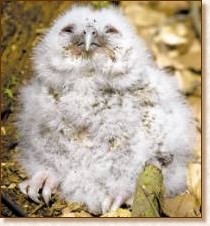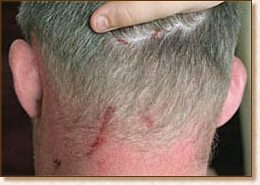 | ||||||||||||||||||||
 | ||||||||||||||||||||
NEWS 2008 page 1 | ||||||||||||||||||||
 | ||||||||||||||||||||
May 17 — Don't believe everything you read in the papers Yet another heartbreakingly misleading (or so I believe) item on fallen Tawny Owl chicks appears in the Buxton Advertiser for 17th May. Showing a 15 or so day-old nestling on the ground, the author writes that such chicks should "certainly not be taken away" as they "have not been abandoned. Once night falls, the parent birds will feed them. The quiet and attentive late night walker may hear the chicks calling loudly for food, their calls getting more impatient as the parent approaches, ...". And more reassuring stuff to make you feel good about leaving the hapless little thing on the ground: "These small white bundles of fluff may no longer be in the nest, but they are not alone. ... A close scrutiny of the surrounding trees will probably reveal an adult sat on one of the branches, keeping a close eye on its progeny." | ||||||||||||||||||||
Right: He may look very jolly in the warm sun, but the fate of this fallen nestling is to become part of the woodland food cycle within a day or two. Photo from the Buxton Advertiser. | ||||||||||||||||||||
I'm afraid this is all nonsense, and as old age creeps up on me I'm increasingly inclined to say so. This poor little chick is going to die. It has been abandoned. It's a nestling, not a fledgling, and it's not supposed to be on the ground. It's had an accident. It has fallen from its nest or hole — most likely from an unsafe open nest because the parents have been unable to find a tree hole. It may well be injured too. You almost certainly won't see the mother keeping a close eye nearby because she'll have realised the chick is doomed and abandoned her nesting effort for the year. (Though she'll look after any other chicks that remain on the nest.) This chick cannot climb back up into the trees as it is a flightless nestling (climbing needs wing assistance) and in any case has no instinct to climb. There's only one place nature has designed it to be — in the nest. The confusion arises because well-intentioned but misinformed 'experts' fail to distinguish between these fallen nestlings and "branchers" — older chicks between about 28 and 35 days old that are in the process of fledging and have left the nest as part of the natural business of growing up and moving out into the world. Unlike nestlings, such chicks do have the instinct and ability to climb. These are the chicks that you'll see with a watching mother nearby and who you'll hear hissing or wheezing for food at night. (This actually continues over the summer months, so you may see more advanced youngsters with a mother later on.) Chicks of this age are not often found on the ground as they're learning to fly fast. They look very different from the little silvery nestling shown in the photo. From what the author of the Buxton Advertiser piece writes it's clear that he's mixing up these two different stages in a tawny chick's development — but then everybody does! It's probably too much to hope that people who claim to know better — and remarkably this includes the big bird organisations and all the owl rescue centres whose offerings I've read — will ever stop giving misguided advice about fallen tawny nestlings. Basically you face a simple choice if you see one of these underage chicks on the ground: pick it up and take it to a rescue centre, or leave it to die. This myth about owls — this mantra of the rehabilitators — is really quite strange as I'd wager quite a lot that there's not an owl expert or rehabilitator in the world who has ever seen with his own eyes a grounded nestling continue to be fed by the parents and successfully make it through to fledging. Not only that, the rehabilitators know very well that owl nestlings are completely helpless and can't climb. It's one of those medieval monks' tales — with a meta-life of its own perpetuated by repeated scribbling, as in the Buxton Advertiser of 17 May 2008. (More on this topic on this website: Why tawny chicks fall from open nests. I'm so puzzled by the widespread belief that fallen nestlings can survive that I'm contacting some experts who really know what they're talking about because they work with these owls out in the wild. One leading expert has already been kind enough to reply with confirmation of my suspicion — that nestlings less than 3 weeks old don't stand a chance if they fall from the nest.) | ||||||||||||||||||||
May 23 — Boudica becomes oldest Tawny Owl mother on record Boudica has lived all her life in Kershope Forest, Cumbria, part of the Forestry Commission's 155,000-acre Kielder Forest. Now 21 years old, she has successfully produced a brood of three, making her the oldest Tawny Owl mother ever and, in about 6 months time, the oldest wild tawny recorded in Britain. See the news item on this BBC News replay page for 23 May. Let's hope it stays available for a while. This shot of Boudica is a still; the video clip shows her chicks being ringed. Clicking on either the pic or the link will take you to the BBC page for the clip. | ||||||||||||||||||||
 | ||||||||||||||||||||
 | ||||||||||||||||||||
May 24 — Bird Forum member reports a Tawny Owl attack Here's his description of an encounter with a parent owl: "Whilst on an evening walk in the local woods today I came across a juvi Tawny Owl that had obviously decided to explore further than the nest hole and its parents were going nuts as it was on the floor. Thinking about the onset of the evening and a prowling Fox looking for an easy meal I decided to 'break the rules' and interfere with nature. I put the chick safely up on a high branch and left. As I was making my way out of the wood I felt an almighty whack to the back of my head! One of the parent birds decided to thank me in a way I wouldn't forget." Click on this Bird Forum thread link for excellent pics of the fledgling, the alarmed looking mother — and a tawny's trademark scratched into the back of a human head. (My thanks to Mike from Ebbw for kind permission to show a couple of thumbs here.) | ||||||||||||||||||||
 | ||||||||||||||||||||
The fledgling (lower pic) is about 30 days old and, happily, more than capable of surviving. It's fledging normally and is probably on its first day out of the nest. Compare its stage of development with the 15-day-old nestling shown in the top news item — there's a world of difference. The only problem is that instead of making it to a branch it's ended up on the ground (the parents would've been "going nuts" because there was a human around). Mike did it a good turn by popping it on a branch. For the results of a more alarming owl attack, see the Powerful Owl item in News 2007. This guy, who was merely thinking about photographing a chick, was lucky not to lose an eye. In this case it was the dad that attacked, although the mother was there too. Often it's just the mother who keeps watch over the fledged chicks. | ||||||||||||||||||||
August 23 — Another variant of the "leave the chick out there" line Extract from the Express and Star, "Britain's biggest and best regional newspaper online". The opinions quoted are those of the director of a well-known wildlife centre. Full article is here. Jenny said: “During the spring many tawny owl chicks are bought to the centre by well-meaning members of the public." Ah, that phrase "well-meaning", always attached to those poor, misguided "members of the public". Read as "ignorant", meaning they don't know what the inner circle of owl people know! "More often than not these owl chicks have become curious and clambered down a tree. Although the parents will continue to care for the chicks, people think they have abandoned them.” Clambered down a tree! My oh my, that's a new one. Everyone else says they clamber up trees, but now it seems they clamber down before clambering up again! I wonder how Jenny explains the sometimes serious injuries these curious little chicks get when clambering down trees. As for being looked after by the parents, I beg to differ. Some are, some aren't — it depends on the age of the chick. The man above was attacked because he handled an older, flight-capable chick that was being minded by the parents. I've seen no evidence that younger chicks at the nestling stage are similarly cared for. People picking them up should get attacked too, but I've yet to hear of this happening. It certainly hasn't happened to me! Gentleshaw staff then have the challenge of rearing them to adulthood without them becoming tame, but the first two for this year flew the nest last week. Bit of an inconsequential sentence by the story-writer, but if the staff really have reared and released young tawnies they'll know that tameness, or indeed imprinting, is hardly an issue, as an increasing number of release studies are showing. Sorry to sound cantankerous, but the interests of hapless little nestlings like the one shown at the top of the page would be better served if wildlife and rehab people had a proper uderstanding of why they end up on the ground and their dismal prospects when they do. To put a figure on it, being picked up by a well-meaning member of the public followed by a brief spell in a rescue centre before release will raise their chances of survival from virtually zero to about 50%. That 50% is a "hard" figure based on release studies. It's about the same as for a normally fledged chick. | ||||||||||||||||||||
powered by owls | ||||||||||||||||||||